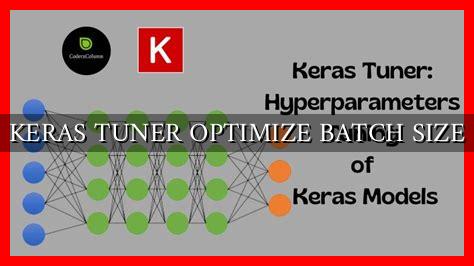-
Table of Contents
The Power of Keras Tuner to Optimize Batch Size
When it comes to training deep learning models, one of the key hyperparameters that can significantly impact performance is the batch size. The batch size determines how many samples are processed before updating the model’s weights, and finding the optimal batch size can lead to faster convergence and better generalization. In this article, we will explore how Keras Tuner can be used to optimize the batch size for your neural network models.
Understanding the Importance of Batch Size
The batch size plays a crucial role in the training process of neural networks. A larger batch size can lead to faster training times, as more samples are processed in parallel. However, larger batch sizes may also result in poorer generalization and convergence to suboptimal solutions.
. On the other hand, smaller batch sizes can improve generalization but may require more training iterations to converge.
Challenges in Selecting the Right Batch Size
Manually selecting the optimal batch size can be a challenging and time-consuming task. It often involves trial and error experimentation, which can be inefficient and may not always lead to the best results. This is where automated hyperparameter tuning tools like Keras Tuner come into play.
Using Keras Tuner to Optimize Batch Size
Keras Tuner is a hyperparameter optimization library that allows you to efficiently search for the best hyperparameters for your deep learning models. It supports various hyperparameter optimization algorithms such as Random Search, Hyperband, and Bayesian Optimization. By leveraging Keras Tuner, you can easily tune hyperparameters like batch size to improve the performance of your models.
Example:
Let’s consider an example where we want to optimize the batch size for a convolutional neural network (CNN) using Keras Tuner. We can define a hyperparameter search space for the batch size and let Keras Tuner search for the optimal value:
“`python
from kerastuner.tuners import RandomSearch
from kerastuner.engine.hyperparameters import HyperParameters
def build_model(hp):
model = Sequential()
model.add(Conv2D(32, (3, 3), activation=’relu’, input_shape=(28, 28, 1)))
model.add(MaxPooling2D((2, 2)))
model.add(Flatten())
model.add(Dense(10, activation=’softmax’))
model.compile(optimizer=’adam’,
loss=’sparse_categorical_crossentropy’,
metrics=[‘accuracy’])
return model
tuner = RandomSearch(
build_model,
objective=’val_accuracy’,
max_trials=10,
hyperparameters=HyperParameters(),
directory=’my_dir’,
project_name=’my_project’
)
tuner.search(x_train, y_train, epochs=5, validation_data=(x_val, y_val))
“`
Benefits of Using Keras Tuner for Batch Size Optimization
- Efficiently search for the optimal batch size without manual intervention.
- Automate the hyperparameter tuning process to save time and resources.
- Improve model performance by finding the best hyperparameters for your specific dataset and architecture.
Conclusion
Optimizing the batch size is a critical step in training deep learning models effectively. By leveraging tools like Keras Tuner, you can automate the process of hyperparameter tuning and find the optimal batch size for your neural network models. This can lead to faster convergence, better generalization, and ultimately improved performance. Experiment with different batch sizes using Keras Tuner and see how it can enhance the training process of your deep learning models.





